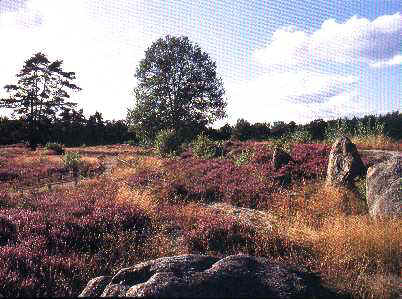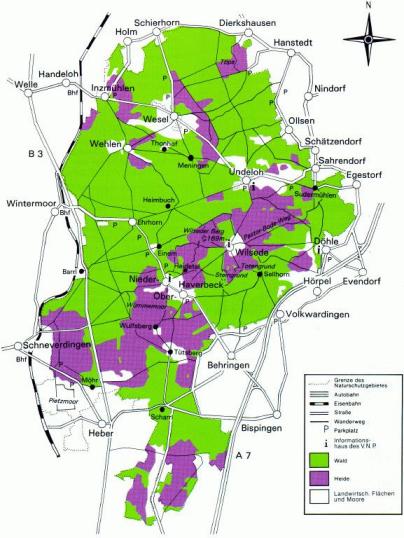Nature Reserve Lüneburger Heide
The Heathland
In the nature reserve Lüneburger Heide
today is kept the biggest rest of a scenery of ca. 50 km², which was
typical for the coastal moor land of Central Europe up to the last third of
the 19th century.

Typical plants of the heathland soil are heather and juniper tree. Gorse with its yellow blossoms and some special species of grass 'Drahtschmiele`und 'Borstgras' are growing. Because of decisive soils and weather influences, concentrated by nitrogen out of air pollution, the 'Drahtschmiele` sometimes displaces the heather for some years. Characteristic for the humid or loamy heathland is the Glockenheide. Already in June she is in pale red bloom. Within the heathland you will find some marshy grounds and small moors. To the typical plants of this places belong the yellow-blossoming Moorlilie and the rarely find blue Lungenenzian. Conspicuous is the cotton grass with its white multiple fruit.
Two animal species are closely connected with the heathland. The honey bee was an important factor for the heath farmers as a deliverer of wax and honey. Today about 4000 bee colonies in their hives are placed in bee houses, when the heather is in bloom. The German Mooreland sheep now is partly kept by tradition, mostly for caring of the heathland. Until the turn of the century a herd of German Mooreland sheep was the live-stock of each farmer. The 'Verein Naturschutzpark' (VNP) owns most of the herds today.

Of the nature reserves living free animals you might observe the birds first. The heathland offers a unique community of breeding colonies. It gives many bird species a lively picture of niches in the biosphere of the by man cultivated and developed historic land. Especially remarkable is the incidence of the Black Grouse. This one makes very complex demands on its living space. Other birds of the heath can be associated to more different structures of the heath such as Wheatear, Woodlark, Tawny Pipit or Nightjar. In spring you can listen to the Tawny Pipit in humid areas, in bushy areas to Great Grey Shrike, Red-backed Shrike, Stonechat and Woodlark.
Map of the Nature Reserve 'Lüneburger Heide'

The Forest
Most of the nature reserve - about 130 km², are forest. Mostly they are forests which have arisen at the end of the 19th century or the last one out of sand dunes, meagre fields or forestation of heathland.
As a pioneer tree species pines have asserted themselves, but also forest keepers usually created pine stands in case of heathland forestation. Nowadays coniferous forest partly are enriched with broad-leafed trees, especially with beeches and oaks.
The bigger animals hide in the
forest. Sometimes you can see their footprints in the sand or loam of the
forest trails or the snow. Often the deer are standing motionless and unrecognized
only about 50 feet away from the trail, glancing at you. In the forest of
the nature reserve about 80 species of breeding birds are found. On average
in one hectare forest are four pair of breeding birds living.
The Moor
Moorland is an in old times often
found form of vegetation in N.W. Germany, nowadays it still occurs in the
nature reserve 'Lüneburger Heide' - even though in small parts only.
The biggest moor, 2,4 km², is the 'Pietzmoor' southeast of Schneverdingen.
You can have a walk through it on a trail which in many parts is lead on planks.
From there you can observe the nature and the animal world.
Houses of Information
The information houses of the 'Verein Naturschutzpark' (VNP) try to give you a better understanding of the historically distinct landscape. It is worth visiting them all, because each house sets a different main focus. In all houses a video (about 15 minutes) is shown as a introduction in this nature reserve.
The Museum of Local History in Wilsede 'Dat ole Huus' - The old House - demonstrates a typical, fully furnished house of heath farmers at the turn of the 19th century. You will find a full description of ancient life and the way the original inhabitants had been working.
The 'Haus der Natur' - House of Nature - in Döhle shows the animal and plant world of the biosphere 'Lüneburger Heide' in different living spaces. Big dioramas present this aspects.
The 'Informationshaus' - House of Information - in Niederhaverbeck gets its main focus on picture boards which will give you a lot of factual information about this area.
Undeloh's 'Informationshaus'
- House of Information - presents you a few very descriptive models.
Verein
Naturschutzpark Lüneburger Heide (VNP)
The organization VNP was found in 1909 in Munich. The extensive conservation in German-speaking regions modelled on the American National Parks is still his aim. Concerning this in the north-German lowlands the nature reserve 'Lüneburger Heide' - 'Naturschutzpark Lüneburger Heide' - was established. In 1910 the 'Wilseder Berg' - Mount Wilsede - was bought. Today the organization owns about 60 km².
The main task of the VNP is taking care for the nature reserve to support a variegated, complex structured biosphere for as many different animal and plant species as possible. Within a test project the VNP grows on his fields historic field crops such as buckwheat and flax. Another sector is information and guidance of visitors.
The VNP is a state-approved non-profit
organization. He is financed only by contributions and membership fees.